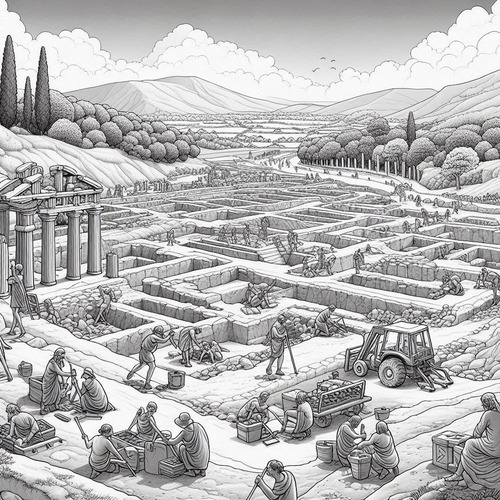Archaeological Finds Validate Bible: Unearthing Biblical Truth
Remarkable Archaeological Finds Validate Bible Narratives
Archaeology, like a patient detective, sifts through layers of time to reveal hidden treasures. In the context of biblical studies, these treasures often come in the form of ancient artefacts, inscriptions, and city ruins. As the spade meets soil, it unearths echoes of the past, validating the historical accuracy of the Scriptures. Join us on a captivating journey through time as we explore archaeological discoveries that not only pique our curiosity but also bolster our confidence in the biblical narratives. From the sands of Mesopotamia to the rocky hills of Jerusalem, these findings provide tangible links between the ancient world and the sacred texts. Let’s delve into the mysteries waiting to be revealed, as we discover how the past illuminates our faith.
- Merneptah Stele: This massive granite inscription from the 13th century BC contains the earliest known reference to “Israel” from an extra-biblical source. This inscription, also known as the Israel Stele, dates back to ancient Egypt and is housed in the Egyptian Museum in Cairo. It contains an account of Merneptah’s victory over the Libyans and a separate campaign in Canaan, mentioning “Israel” in line 27. The text boasts of the Egyptian pharaoh Merneptah’s victory over peoples in Canaan, including a people group referred to as “Israel.” This corroborates the Bible’s depiction of Israel as an established nation during this time period.
- Tel Dan Stele and the Existence of David: This broken inscribed stone, dated to the 9th century BC, was discovered in northern Israel in 1993. For years, the existence of the biblical King David was questioned due to a lack of conclusive archaeological evidence. However, that changed in 1993 with the discovery of the Tel Dan Stele. It contains an Aramaic inscription that refers to the “House of David,” providing evidence that the biblical King David was a real historical figure and that his family line formed a royal dynasty. This supports the biblical narrative about David in 1 and 2 Samuel.
- Cyrus Cylinder: This clay cylinder from 539 BC contains a transcribed declaration from the Persian King Cyrus. It describes Cyrus’ policy of allowing deported peoples to return to their homelands and restore their temples – an act that directly aligns with the biblical account of Cyrus allowing the Jews to return to Jerusalem from Babylonian exile (Ezra 1).
- Pilate Stone: This carved limestone inscription from the 1st century AD bears the name “Pontius Pilatus, Prefect of Judea” – the same Pontius Pilate described in the Gospels as the Roman ruler who presided over Jesus’ trial. Its existence lends credibility to the biblical details about Pilate’s role.
- Siloam Inscription: Etched into the walls of Jerusalem’s Hezekiah’s Tunnel, this ancient Hebrew inscription records the completion of the tunnel’s construction – a project mentioned in 2 Kings 20:20 and 2 Chronicles 32:30. Its archaic Hebrew writing style dates it to around 700 BC, corroborating this biblical public works project.
- Lachish Relief: This Assyrian stone relief panel depicts the military conquest of the biblical city of Lachish (as mentioned in 2 Kings 18-19, 2 Chron. 32, etc.). Its graphic scenes of violence and siege warfare align with the biblical accounts of Assyrian ruler Sennacherib’s invasion of Judah in 701 BC.
- Moabite Stone: Also called the Mesha Stele, this inscribed basalt stone mentions the “House of Omri” and the “Land of Medeba” – referring to the biblical King Omri of Israel and territory described in the Bible (1 Kings 16). Its text helps confirm that Omri was a historical ruler over an Israeli kingdom in the 9th century BC.
- Ketef Hinnom Scrolls: Discovered in excavations near Jerusalem, these two small silver scroll amulets contain texts from Numbers 6:24-26, indicating that the priestly benediction (and the Book of Numbers itself) dates back to around the 6th century BC. This shows that portions of the biblical text existed very anciently.
- The Babylonian Siege of Jerusalem: The biblical account of the Babylonian destruction of Jerusalem in 587/586 B.C. has been reinforced by excavations in the ancient city. Archaeologists have uncovered layers of ash and debris, as well as arrowheads and lamps, precisely dating back to that era, aligning with the scriptural narrative. Additionally, the Babylonian Chronicle, a contemporary inscription, independently confirms Babylon’s conquest of Judah.
- The Israelite Exodus from Egypt: While the exact details continue to be debated, archaeological evidence supports key aspects of the biblical Exodus story. The ancient Egyptian city of Rameses, mentioned in Exodus as a staging area for Hebrew slaves, has been identified as the archaeological site of Qantir. Remains of mud-brick buildings and grain silos suggest a sizeable Hebrew population once lived there. Furthermore, the ancient Brooklyn Papyri document semitic slave laborers in Egypt during the relevant time period.
- The Garden Tomb: An ancient burial site known as the Garden Tomb in Jerusalem has yielded significant archaeological evidence consistent with the Gospel accounts. Within its grounds, archaeologists discovered an ancient wine press, cisterns used for purification rituals, and an ancient Jewish tomb entrance design consistent with the biblical description of Jesus’ tomb. The Garden Tomb’s location also matches details provided in biblical and early non-biblical sources.
Overall, these artefacts provide extra-biblical evidence that helps corroborate the historical accuracy of biblical people, places, events and texts described throughout the Old and New Testaments. For those open to evaluating the evidence, these finds present a compelling case for the Bible’s historicity and reliability as an ancient record.
Related Reads:
- Papyri and Dead Sea Scrolls: Archaeology Endorses Scripture
- Historical Reliability of the Bible: Astonishing Archaeological Finds
- Canonicity: The Journey to the Bible We Know Today
- Preservation and Transmission of the Bible: Insights into Textual Criticism
- Connecting the Dots: How Undesigned Coincidences Confirm Bible Reliability
Editor's Pick

Prevenient Grace: 5 Reasons the Doctrine Fails
Can a spiritually dead person choose God? It’s one of the oldest questions in Christian theology. And how we answer [...]

Why Do People Hate the Doctrine of Election?
…WHEN THEY REALLY SHOULDN’T Few Bible doctrines provoke stronger reactions than election. The idea that God chose some for salvation [...]

The Doctrine of Providence: Does God Really Govern All Things?
You’re sitting in the doctor’s office when the diagnosis lands like a thunderclap. Your mind races: Why this? Why now? [...]
SUPPORT US:
Feel the Holy Spirit's gentle nudge to partner with us?
Donate Online:
Account Name: TRUTHS TO DIE FOR FOUNDATION
Account Number: 10243565459
Bank IFSC: IDFB0043391
Bank Name: IDFC FIRST BANK






